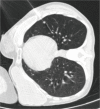Management of incidental lung nodules <8 mm in diameter
- PMID: 30345098
- PMCID: PMC6178302
- DOI: 10.21037/jtd.2018.05.86
Management of incidental lung nodules <8 mm in diameter
Abstract
Due to the increase of incidentally detected pulmonary nodules and the information obtained from several screening programs, updated guidelines with new recommendations for the management of small pulmonary nodules have been proposed. These international guidelines coincide in proposing periodic follow-up for small nodules, less than 8 mm of diameter. Fleischner and British Thoracic Society guidelines are the most recent and popular guidelines for incidental pulmonary nodules management. They have specific recommendations according to nodule characteristics (density and size) and cancer risk of the patient. Both guidelines separate recommendations for solid and subsolid nodules. Predictive risk models have been developed to improve the nodule management. In certain cases follow up may not be the best option. We discuss the scenarios and options to achieve a histologic diagnosis of these tiny pulmonary nodules.
Keywords: Pulmonary nodules; computed tomography; lung cancer; management.
Conflict of interest statement
Conflicts of Interest: The authors have no conflicts of interest to declare.
Figures


















References
-
- Rami-Porta R, Bolejack V, Crowley J, et al. The IASLC Lung Cancer Staging Project: Proposals for the Revisions of the T Descriptors in the Forthcoming Eighth Edition of the TNM Classification for Lung Cancer. J Thorac Oncol 2015;10:990-1003. - PubMed
Publication types
LinkOut - more resources
Full Text Sources
